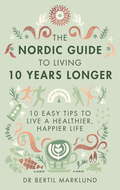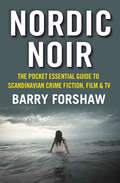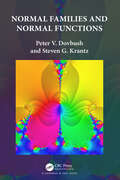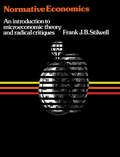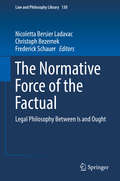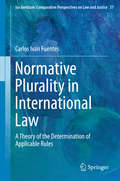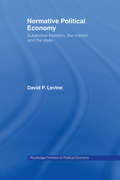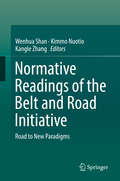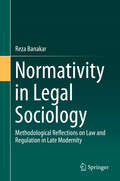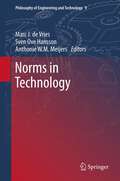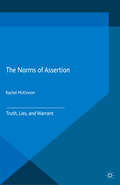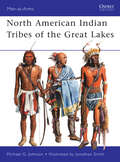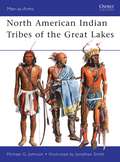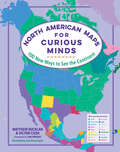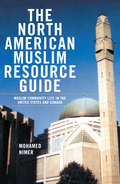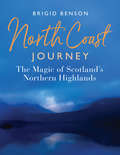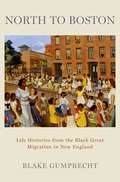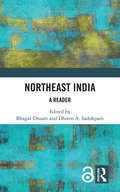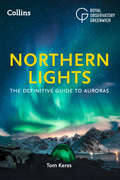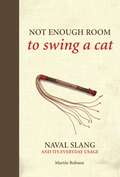- Table View
- List View
The Nordic Guide to Living 10 Years Longer: 10 Easy Tips to Live a Healthier, Happier Life
by Dr. Bertil MarklundThe Danes may have their hygge and the Norwegians their back to the land culture, but the Swedes have 'lagom': an even-keeled approach to a life of balance.Dr Bertil Marklund - a doctor and researcher at the Gothenburg University with over forty years of experience - provides the most cutting-edge research to explain the ten areas we should focus on to better our chances of a long life.This compact guide provides wisdom from the Nordics, a region long known for its healthy and progressive lifestyle. It debunks myths on things we have been told are not good for us but actually can be: did you know drinking coffee will promote your health? Or that more people die of lack of Vitamin D than they do of skin cancer? By providing pragmatic and realistic advice, Dr Marklund gives you the power to make a difference in your own life today and for the future.
Nordic Noir: The Pocket Essential Guide to Scandinavian Crime Fiction, Film & TV
by Barry ForshawNordic Noir: The Pocket Essential Guide to Scandinavian Crime Fiction, Film and TV by Britain's leading expert on crime fiction, Barry Forshaw, is a compact and authoritative guide to the phenomenally popular genre.The information-packed study examines and celebrates books, films and TV adaptations, from Sjöwall & Wahlöö's highly influential Martin Beck series through Henning Mankell's Wallander (subject of three separate TV series) to Stieg Larsson's groundbreaking The Girl with the Dragon Tattoo, cult TV hits such as the Danish The Killing, The Bridge, and the political thriller Borgen, up to the massively successful books and films of the current king of the field, Norway's Jo Nesbo. Nordic Noir anatomises the nigh-obsessive appeal of the subject and highlights every key book, film and TV show. For both the beginner and the aficionado, this is a hugely informative, highly accessible guide (and shopping list) for an essential crime genre.'Entertaining and informative companion ... written by the person who probably knows more than anyone alive about the subject' - The Times'Readers wanting to get into Scandinavian crime fiction should start with Forshaw's pocket guide to the genre' - Financial TimesLook out for the other books in Barry Forshaw's Noir series Euro Noir, Brit Noir, American Noir and Historical Noir, and for his latest book, Crime Fiction: A Reader's Guide.
Normal Families and Normal Functions
by Peter V. Dovbush Steven G. KrantzThis book centers on normal families of holomorphic and meromorphic functions and also normal functions. The authors treat one complex variable, several complex variables, and infinitely many complex variables (i.e., Hilbert space).The theory of normal families is more than 100 years old. It has played a seminal role in the function theory of complex variables. It was used in the first rigorous proof of the Riemann mapping theorem. It is used to study automorphism groups of domains, geometric analysis, and partial differential equations.The theory of normal families led to the idea, in 1957, of normal functions as developed by Lehto and Virtanen. This is the natural class of functions for treating the Lindelof principle. The latter is a key idea in the boundary behavior of holomorphic functions.This book treats normal families, normal functions, the Lindelof principle, and other related ideas. Both the analytic and the geometric approaches to the subject area are offered. The authors include many incisive examples.The book could be used as the text for a graduate research seminar. It would also be useful reading for established researchers and for budding complex analysts.
Normal Families and Normal Functions
by Peter V. Dovbush Steven G. KrantzThis book centers on normal families of holomorphic and meromorphic functions and also normal functions. The authors treat one complex variable, several complex variables, and infinitely many complex variables (i.e., Hilbert space).The theory of normal families is more than 100 years old. It has played a seminal role in the function theory of complex variables. It was used in the first rigorous proof of the Riemann mapping theorem. It is used to study automorphism groups of domains, geometric analysis, and partial differential equations.The theory of normal families led to the idea, in 1957, of normal functions as developed by Lehto and Virtanen. This is the natural class of functions for treating the Lindelof principle. The latter is a key idea in the boundary behavior of holomorphic functions.This book treats normal families, normal functions, the Lindelof principle, and other related ideas. Both the analytic and the geometric approaches to the subject area are offered. The authors include many incisive examples.The book could be used as the text for a graduate research seminar. It would also be useful reading for established researchers and for budding complex analysts.
Normative Economics: An Introduction to Microeconomic Theory and Radical Critiques
by Frank J. StilwellNormative Economics: An Introduction to Microeconomic Theory and Radical Critiques seeks to overcome the problem of taking an orthodox approach in economics introducing it in a critical way. The book covers social objectives and functions of economics; the development of a theory of commodity distribution and exchange; the determinating factors of different production techniques; the identification and determination of the combination of goods; the effects of locations and places on microeconomics; and the effects of time on microeconomics. Also discussed in the book are the implications of public policy; neo-classical economics; and other economic structures. The text is recommended not only for students of microeconomics, but also for economists and financial analysts, as it offers a different and refreshing approach to the subject.
The Normative Force of the Factual: Legal Philosophy Between Is and Ought (Law and Philosophy Library #130)
by Nicoletta Bersier Ladavac Christoph Bezemek Frederick SchauerThis book explores the interrelation of facts and norms. How does law originate in the first place? What lies at the roots of this phenomenon? How is it preserved? And how does it come to an end? Questions like these led Georg Jellinek to speak of the “normative force of the factual” in the early 20th century, emphasizing the human tendency to infer rules from recurring events, and to perceive a certain practice not only as a fact but as a norm; a norm which not only allows us to distinguish regularity from irregularity, but at the same time, to treat deviances as transgressions. Today, Jellinek’s concept still provides astonishing insights on the dichotomy of “is” and “ought to be”, the emergence of the normative, the efficacy and the defeasibility of (legal) norms, and the distinct character of what legal theorists refer to as “normativity”. It leads us back to early legal history, it connects anthropology and legal theory, and it demonstrates the interdependence of law and the social sciences. In short: it invites us to fundamentally reassess the interrelation of facts and norms from various perspectives. The contributing authors to this volume have accepted that invitation.
Normative Plurality in International Law: A Theory of the Determination of Applicable Rules (Ius Gentium: Comparative Perspectives on Law and Justice #57)
by Carlos Iván FuentesThis book provides a theoretical framework for explaining the choices made by international decision-makers in terms of what constitutes law. It comprehensively analyzes the practice of human rights courts in applying legal instruments outside their competence and proposes that this practice recognizes that different normative instruments coexist in an un-ordered space, and that meaning can be produced by the free interaction of those instruments around a problem. Based on this, the book advances its normative plurality hypothesis, which states that decision-makers must survey the acquis of international law in order to identify all the instruments containing relevant normative information for a particular situation. The set of rules of law applicable to the situation must then be complemented with other instruments containing specific normative information relevant to the situation, resulting in a complete system of norms advancing a common purpose.
Normative Political Economy: Subjective Freedom, the Market and the State
by David P. LevineNormative Political Economy explores the criteria we use for judging economic institutions and economic policy. It argues that prevailing criteria lack sufficient depth in their understanding of subjective experience. David Levine's arguments cover topics which include: * basic needs, equality and justice * freedom, self-integration and creative living * the role of the state * capitalism and the good society
Normative Political Economy: Subjective Freedom, the Market and the State
by David P. LevineNormative Political Economy explores the criteria we use for judging economic institutions and economic policy. It argues that prevailing criteria lack sufficient depth in their understanding of subjective experience. David Levine's arguments cover topics which include: * basic needs, equality and justice * freedom, self-integration and creative living * the role of the state * capitalism and the good society
Normative Readings of the Belt and Road Initiative: Road to New Paradigms
by Wenhua Shan Kimmo Nuotio Kangle ZhangThis timely book offers revealing insights into the changing role of China in world governance as exemplified by the Silk Road Initiative, the People’s Republic’s first published major initiative for external affairs. Focusing on various aspects of the Silk Road Initiative, particularly those that are largely neglected in current discussions, including culture and philosophy, finance and investment, environmental protection and social responsibility, judiciary and lawyers, the authors explore a wide range of contexts in which China’s role as an emerging power in international relations and international law is examined. In the current era of ever-increasing populism, protectionism and challenges to globalization, the authors explore the Chinese philosophy underpinning Chinese norms of regional and international development. Bearing in mind the political and economic uncertainties hampering the establishment of such norms, the authors offer crucial insights into how the Silk Road Initiative could or should be developed and regulated.Given its depth of coverage, the book is an indispensable read for anyone interested in the Initiative and its social-legal implications.
Normativity in Legal Sociology: Methodological Reflections on Law and Regulation in Late Modernity
by Reza BanakarThe field of socio-legal research has encountered three fundamental challenges over the last three decades – it has been criticized for paying insufficient attention to legal doctrine, for failing to develop a sound theoretical foundation and for not keeping pace with the effects of the increasing globalization and internationalization of law, state and society. This book examines these three challenges from a methodological standpoint. It addresses the first two by demonstrating that legal sociology has much to say about justice as a kind of social experience and has always engaged theoretically with forms of normativity, albeit on its own empirical terms rather than on legal theory’s analytical terms. The book then explores the third challenge, a result of the changing nature of society, by highlighting the move from the industrial relations of early modernity to the post-industrial conditions of late modernity, an age dominated by information technology. It poses the question whether socio-legal research has sufficiently reassessed its own theoretical premises regarding the relationship between law, state and society, so as to grasp the new social and cultural forms of organization specific to the twenty-first century’s global societies.
Norms in Technology (Philosophy of Engineering and Technology #9)
by Marc J. Vries, Sven Ove Hansson and Anthonie W.M. MeijersThis book is a distinctive fusion of philosophy and technology, delineating the normative landscape that informs today’s technologies and tomorrow’s inventions. The authors examine what we deem to be the internal norms that govern our ever-expanding technical universe. Recognizing that developments in technology and engineering literally create our human future, transforming existing knowledge into tomorrow’s tools and infrastructure, they chart the normative criteria we use to evaluate novel technological artifacts: how, for example, do we judge a ‘good’ from a ‘bad’ expert system or nuclear power plant? As well as these ‘functional’ norms, and the norms that guide technological knowledge and reasoning, the book examines commonly agreed benchmarks in safety and risk reduction, which play a pivotal role in engineering practice.Informed by the core insight that, in technology and engineering, factual knowledge relating, for example, to the properties of materials or the load-bearing characteristics of differing construction designs is not enough, this analysis follows the often unseen foundations upon which technologies rest—the norms that guide the creative forces shaping the technical landscape to come. The book, a comprehensive survey of these emerging topics in the philosophy of technology, clarifies the role these norms (epistemological, functional, and risk-assessing) play in technological innovation, and the consequences they have for our understanding of technological knowledge.
The Norms of Assertion: Truth, Lies, and Warrant (Palgrave Innovations in Philosophy)
by R. McKinnonWhen we make claims to each other, we're asserting. But what does it take to assert well? Do we need to know what we're talking about? This book argues that we don't. In fact, it argues that in some special contexts, we can lie.
North American Indian Tribes of the Great Lakes (Men-at-Arms #467)
by Michael G JohnsonThis book details the growth of the European Fur trade in North America and how it drew the Native Americans who lived in the Great Lakes region, notably the Huron, Dakota, Sauk and Fox, Miami and Shawnee tribes into the colonial European Wars. During the French and Indian War, the American Revolution, and the War of 1812, these tribes took sides and became important allies of the warring nations. However, slowly the Indians were pushed westward by the encroachment of more settlers. This tension finally culminated in the 1832 Black Hawk's War, which ended with the deportation of many tribes to distant reservations.
North American Indian Tribes of the Great Lakes (Men-at-Arms)
by Jonathan Smith Michael G JohnsonThis book details the growth of the European Fur trade in North America and how it drew the Native Americans who lived in the Great Lakes region, notably the Huron, Dakota, Sauk and Fox, Miami and Shawnee tribes into the colonial European Wars. During the French and Indian War, the American Revolution, and the War of 1812, these tribes took sides and became important allies of the warring nations. However, slowly the Indians were pushed westward by the encroachment of more settlers. This tension finally culminated in the 1832 Black Hawk's War, which ended with the deportation of many tribes to distant reservations.
North American Maps for Curious Minds: 100 New Ways to See the Continent
by Matthew Bucklan Victor CizekThe Maps for Curious Minds series is back—with 100 vivid infographic maps that transform the way we understand the cultural and geographical wonders of North America No matter how well you think you know North America, the 100 infographic maps in this singular atlas uncover a trove of fresh wonders that make the continent seem like the center of the universe. Did you know that North America is where the first T. rex was found? Or that it&’s where you can visit the world&’s biggest geode as well as its oldest, tallest, and largest trees—not to mention the world&’s tallest and steepest roller coasters?! Brimming with fascinating insight (Who is the highest-paid public employee in each state?) and whimsical discovery (Where can you visit the world&’s largest island in a lake on an island in a lake on an island?), this book highlights the unexpected contours of geography, history, nature, politics, and culture, revealing new ways to see North America—and the hundreds of millions who call it home.
The North American Muslim Resource Guide: Muslim Community Life in the United States and Canada
by Mohamed NimerThis useful resource provides basic information about Islamic life in the United States. Coverage includes population statistics and analysis, as well as immigration information that tracks the settlement of Islamic people in the America. The guide contains contact information for mosques, community organizations, schools, women's groups, media, and student groups. Recent Islamic-American events over the past five years are also reviewed.To see the Introduction, the table of contents, a generous selection of sample pages, and more, visit the The North American Muslim Resource Guide website.
The North American Muslim Resource Guide: Muslim Community Life in the United States and Canada
by Mohamed NimerThis useful resource provides basic information about Islamic life in the United States. Coverage includes population statistics and analysis, as well as immigration information that tracks the settlement of Islamic people in the America. The guide contains contact information for mosques, community organizations, schools, women's groups, media, and student groups. Recent Islamic-American events over the past five years are also reviewed.To see the Introduction, the table of contents, a generous selection of sample pages, and more, visit the The North American Muslim Resource Guide website.
North Coast Journey: The Magic of Scotland’s Northern Highlands - As seen on Jeremy Clarkson's 'Grand Tour'
by Brigid BensonThis is the essential guide to the north of Scotland, on a route which begins in Inverness, weaves westwards to Applecross and then northwards towards Torridon. From Ullapool it leads to the most northerly points in Britain, passing by Caithness and John o’ Groats before heading south again through Dingwall and to Inverness.In addition to stunning mountains, moors, lochs and beaches, the route also featuresexquisite towns and villages, castles, distilleries, breweries, natural wonders and wildlife.Brigid Benson, who knows the road intimately, divides the route into manageable chunks, suggesting where to discover history, observe wildlife, meet great local characters, shop at quirky stores, taste outstanding food, drink in friendly bars and cafes, stand in awe of amazing sights, and recommending places to picnic, swim, surf, walk and stargaze. And great places to camp and stay. She also draws attention to attention to potential pitfalls, offering useful advice on single-track roads, fuel, car problems, planning realistic itineraries, and much more.
North to Boston: Life Histories from the Black Great Migration in New England
by Blake GumprechtBetween World War II and 1980, tens of thousands of Black people moved to Boston from the South as part of the Great Migration, one of the most consequential mass movements of people in American history. Black migration from the South transformed the city, as it did urban areas across the country. North to Boston is the first book to examine that important subject. Blake Gumprecht traces the history of this migration and explores its impacts in greater depth through the lives of ten individuals, each the subject of one chapter. Those chapters are short biographies based on extensive interviews by the author and are told in an engaging style that reflects the author's background as a journalist. The ten people featured came from six southern states. They fled racism, limited opportunity, and hopelessness, and moved north in pursuit of better jobs, equal treatment, and greater freedom. They settled in neighborhoods such as Roxbury, Dorchester, and Mattapan. They worked as teachers, factory workers, welders, and security guards. Their stories are emblematic of the experiences of Black people everywhere who left the South, and provide a rare glimpse into the lives of ordinary people living in one city's Black community. North to Boston brings to life the history of the Great Migration, revealing a hidden aspect of New England's history and shining a spotlight on a singularly important event in the making of Black Boston.
North to Boston: Life Histories from the Black Great Migration in New England
by Blake GumprechtBetween World War II and 1980, tens of thousands of Black people moved to Boston from the South as part of the Great Migration, one of the most consequential mass movements of people in American history. Black migration from the South transformed the city, as it did urban areas across the country. North to Boston is the first book to examine that important subject. Blake Gumprecht traces the history of this migration and explores its impacts in greater depth through the lives of ten individuals, each the subject of one chapter. Those chapters are short biographies based on extensive interviews by the author and are told in an engaging style that reflects the author's background as a journalist. The ten people featured came from six southern states. They fled racism, limited opportunity, and hopelessness, and moved north in pursuit of better jobs, equal treatment, and greater freedom. They settled in neighborhoods such as Roxbury, Dorchester, and Mattapan. They worked as teachers, factory workers, welders, and security guards. Their stories are emblematic of the experiences of Black people everywhere who left the South, and provide a rare glimpse into the lives of ordinary people living in one city's Black community. North to Boston brings to life the history of the Great Migration, revealing a hidden aspect of New England's history and shining a spotlight on a singularly important event in the making of Black Boston.
Northeast India: A Reader
by Bhagat Oinam Dhiren A. SadokpamNortheast India is a multifaceted and dynamic region that is constantly in focus because of its fragile political landscape characterized by endemic violence and conflicts. One of the first of its kind, this reader on Northeast India examines myriad aspects of the region – its people and its linguistic and cultural diversity. The chapters here highlight the key issues confronted by the Northeast in recent times: its history, politics, economy, gender equations, migration, ethnicity, literature and traditional performative practices. The book presents interlinkages between a range of socio-cultural issues and armed political violence while covering topics such as federalism, nationality, population, migration and social change. It discusses debates on development with a view to comprehensive policies and state intervention. With its a nuanced and wide-ranging overview, this volume makes new contributions to understanding a region that is critical to the future of South Asian geopolitics. The book will be of great interest to scholars and researchers of contemporary Northeast India as well as history, political science, area studies, international relations, sociology and social anthropology. It will also appeal to those interested in public administration, regional literature, cultural studies, population studies, development studies and economics.
Northeast India: A Reader
by Bhagat Oinam Dhiren A. SadokpamNortheast India is a multifaceted and dynamic region that is constantly in focus because of its fragile political landscape characterized by endemic violence and conflicts. One of the first of its kind, this reader on Northeast India examines myriad aspects of the region – its people and its linguistic and cultural diversity. The chapters here highlight the key issues confronted by the Northeast in recent times: its history, politics, economy, gender equations, migration, ethnicity, literature and traditional performative practices. The book presents interlinkages between a range of socio-cultural issues and armed political violence while covering topics such as federalism, nationality, population, migration and social change. It discusses debates on development with a view to comprehensive policies and state intervention. With its a nuanced and wide-ranging overview, this volume makes new contributions to understanding a region that is critical to the future of South Asian geopolitics. The book will be of great interest to scholars and researchers of contemporary Northeast India as well as history, political science, area studies, international relations, sociology and social anthropology. It will also appeal to those interested in public administration, regional literature, cultural studies, population studies, development studies and economics.
Northern Lights: The Definitive Guide To Auroras
by Tom Kerss Royal Observatory Greenwich Collins AstronomyDiscover the incomparable beauty of the Northern Lights with this accessible guide for aspiring astronomers and seasoned night sky observers. Covers the essential equipment needed for observation and photography and full of stunning photographs.
Not Enough Room to Swing a Cat: Naval slang and its everyday usage
by Martin RobsonAs the crow flies'', ''chunder'', ''cold enough to freeze the balls off a brass monkey'', ''three sheets to the wind'' - many terms like these are used in everyday English language conversation and writing. But how many landlubbers know that they derive from naval slang or know what the phrase originally referred to? The navy has helped to shape modern society. The navy is famous for its traditions, quirks and nuances. It is disinctly different to wider society and nowhere is this more evident than in language. The naval community once had its own language, incomprehensible to anyone who was not a sailor, which described and explained his unique world. But on shore leave these men introduced their language to the populations of bustling ports and harbours and the usage slowly spread inland. Today through the mediums of film, television and music, naval slang has been brought to the wider public and has become fully integrated into the English language to point where many phrases are used by people who have no concept of their meaning. Presenting terminology thematically, this book provides a compilation of naval slang throughout the world, from terms relating to ship-handling and seamanship through to food and drink, discipline and insults. The text is further enhanced with original black line drawings that illustrate certain technical terms, such as ''splice the mainbrace''.
